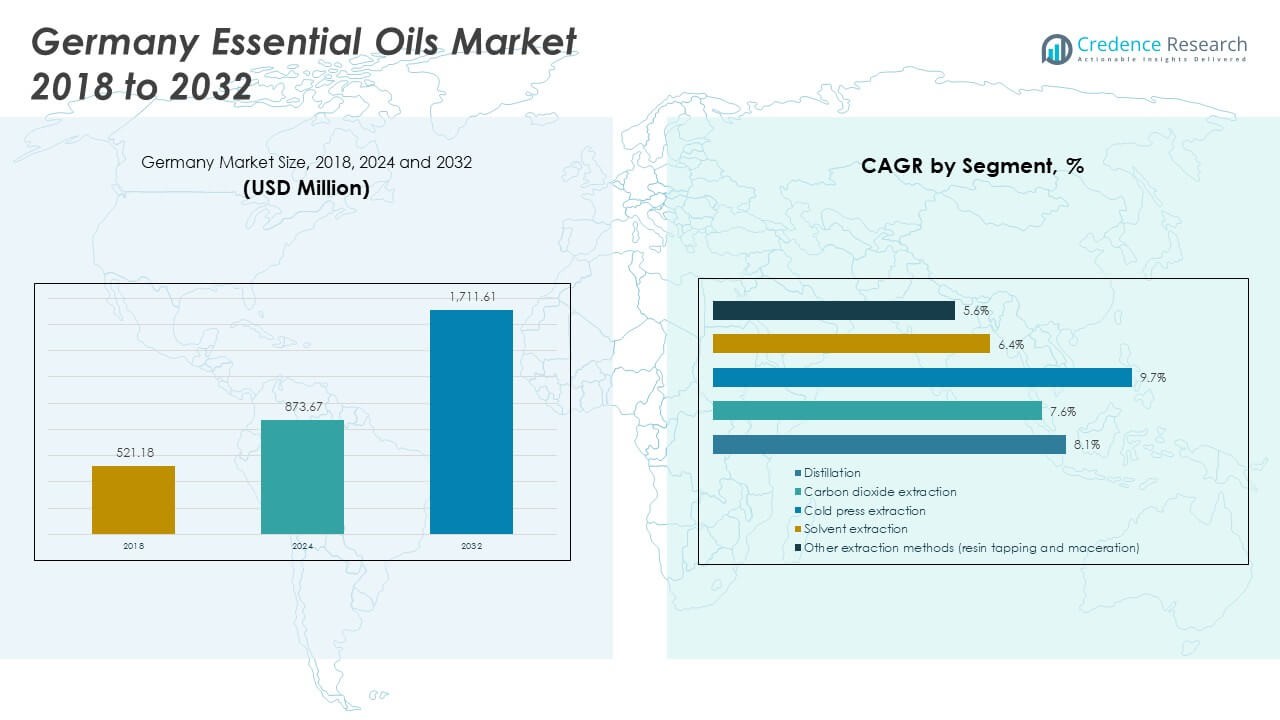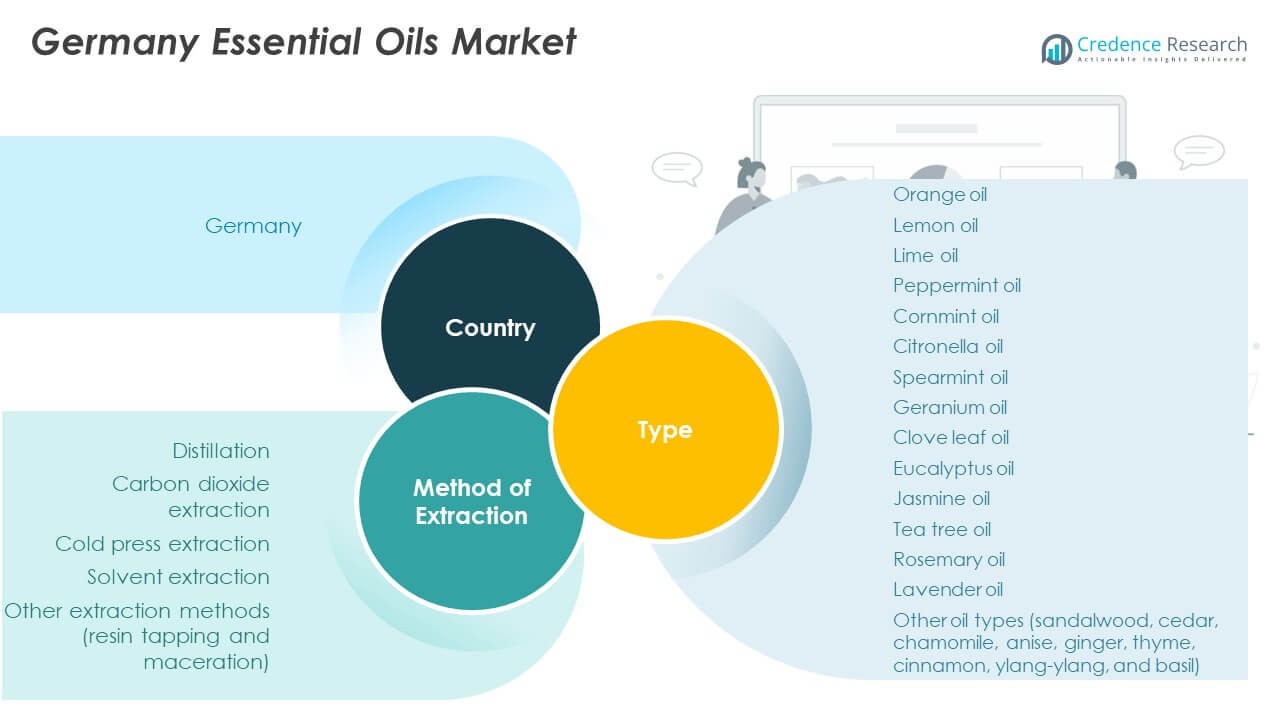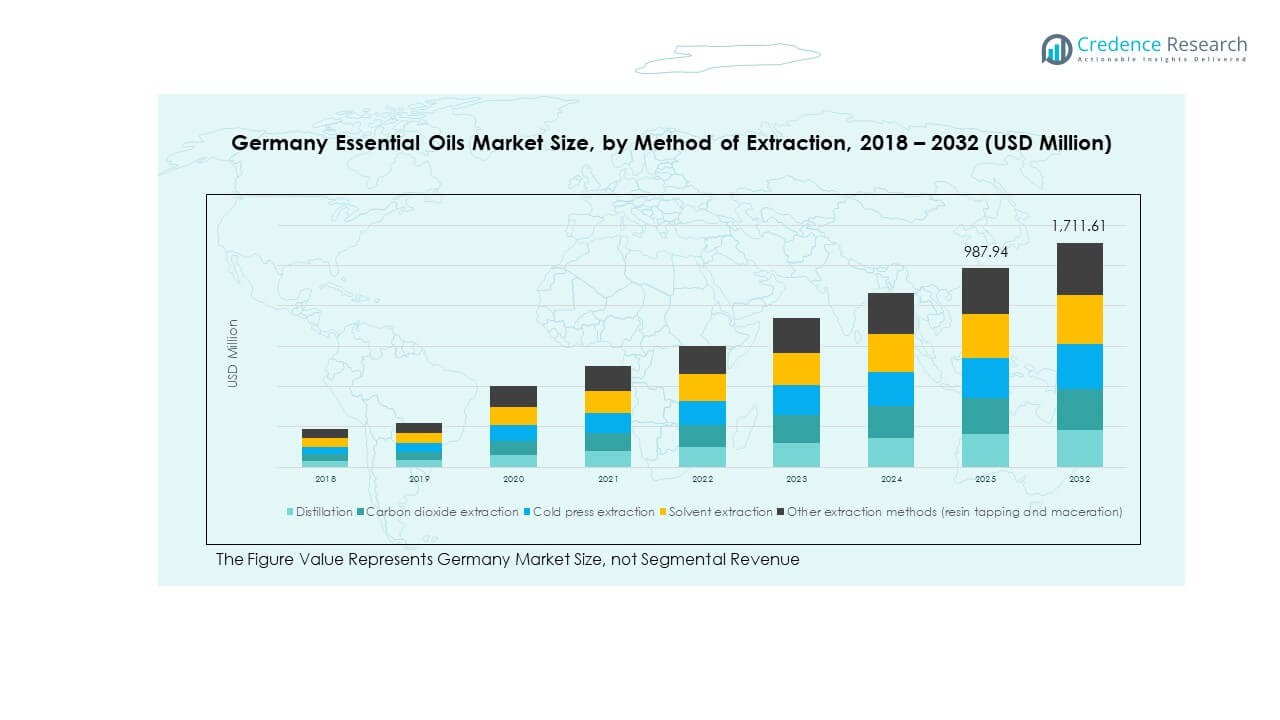Market Overview:
The Germany Wood Essential Oils Market size was valued at USD 521.18 million in 2018 to USD 873.67 million in 2024 and is anticipated to reach USD 1,711.61 million by 2032, at a CAGR of 8.17% during the forecast period.
| REPORT ATTRIBUTE |
DETAILS |
| Historical Period |
2020-2023 |
| Base Year |
2024 |
| Forecast Period |
2025-2032 |
| Germany Wood Essential Oils Market Size 2024 |
USD 873.67 Million |
| Germany Wood Essential Oils Market, CAGR |
8.17% |
| Germany Wood Essential Oils Market Size 2032 |
USD 1,711.61 Million |
The market is experiencing strong demand from personal care, aromatherapy, and household applications. Growing consumer preference for natural and plant-based solutions drives adoption. Rising awareness about therapeutic benefits of wood oils further supports growth across Germany. Increased use in fragrances, cosmetics, and alternative medicine is strengthening long-term prospects.
Germany has positioned itself as a leading hub for essential oils in Europe. Strong consumer interest in sustainable and eco-friendly products fuels steady demand. Northern and Western Europe remain primary markets, while Eastern Europe shows increasing adoption. The country benefits from its established fragrance and cosmetics industries, creating new export opportunities.
Access crucial information at unmatched prices!
Request your sample report today & start making informed decisions powered by Credence Research Inc.!
Download Sample
Market Insights:
- The Germany Wood Essential Oils Market was valued at USD 521.18 million in 2018, USD 873.67 million in 2024, and is expected to reach USD 1,711.61 million by 2032, growing at a CAGR of 8.17%.
- Europe held the largest regional share in 2024 at 38%, followed by North America with 30% and Asia Pacific with 24%, driven by strong wellness adoption, advanced cosmetic industries, and growing consumer awareness.
- Asia Pacific is the fastest-growing region with 24% share, supported by rising disposable incomes, urbanization, and demand for natural personal care and aromatherapy solutions.
- Distillation accounted for around 46% of the market share in 2024, maintaining dominance due to scalability and efficiency in production.
- Carbon dioxide extraction held about 22% share, reflecting its rising use in producing high-purity, sustainable oils for premium applications.

Market Drivers:
Rising Demand for Natural and Sustainable Wellness Products:
The Germany Wood Essential Oils Market benefits from a surge in consumer preference for natural wellness products. Demand grows as buyers increasingly seek chemical-free, eco-friendly alternatives for personal care and home use. Companies expand product lines to meet strict sustainability standards, reinforcing brand credibility. Aromatherapy practices integrate wood oils to reduce stress and enhance wellbeing, fueling higher consumption. Rising concerns about synthetic fragrance impacts also accelerate demand for plant-based oils. Distribution across pharmacies, wellness centers, and online stores expands accessibility. It strengthens the market by meeting both wellness and lifestyle trends.
- For instance, Buyers increasingly seek products meeting strict sustainability standards, reinforced by companies expanding product lines with transparent supply chains and certifications. Aromatherapy practices incorporating wood oils like cedarwood and sandalwood have been shown in some studies to help reduce stress levels, boosting consumption across pharmacies, wellness centers, and online platforms.
Expansion of Cosmetic and Personal Care Applications:
Cosmetic manufacturers in Germany integrate wood essential oils into skincare, haircare, and fragrance products. The oils provide moisturizing, anti-inflammatory, and antimicrobial benefits, supporting natural cosmetic innovation. Rising demand for herbal-based formulations pushes companies to invest in wood oil blends. German beauty brands adopt oils like sandalwood and cedarwood to align with clean-label trends. Consumers value therapeutic benefits, enhancing long-term adoption in premium cosmetic lines. Rising disposable incomes support purchases of high-quality, natural cosmetics. Distribution across drugstores and supermarkets ensures strong consumer reach. This expansion strengthens the market position across beauty and personal care.
- For instance, Cosmetic manufacturers integrate wood essential oils for their proven moisturizing, anti-inflammatory, and antimicrobial benefits. Rising demand for herbal-based formulations motivates investment in wood oil blends like sandalwood and cedarwood, aligning with clean-label trends favored by German consumers.
Growth in Aromatherapy and Alternative Medicine Practices:
Aromatherapy has become a major driver for the Germany Wood Essential Oils Market. Consumers turn to oils for stress relief, relaxation, and mood enhancement. Health practitioners integrate wood oils into holistic therapies for respiratory and immune support. Rising acceptance of complementary medicine boosts usage across spas and wellness centers. Oils like cedarwood and sandalwood gain popularity for their calming properties. Growing adoption among urban consumers drives regular purchases for home use. Distribution channels such as online platforms and specialty stores improve product availability. Rising awareness of mental wellness fuels growth in this sector.
Rising Industrial and Household Applications Beyond Wellness:
The Germany Wood Essential Oils Market expands beyond personal wellness into household and industrial applications. Cleaning product manufacturers integrate oils for natural fragrance and antimicrobial properties. Demand grows in air fresheners, detergents, and insect repellents, where consumers prefer chemical-free options. Industrial players adopt oils for sustainable formulations in coatings and adhesives. Use in food flavoring and beverages adds another layer of opportunity. German households increasingly buy oils for daily lifestyle use, from diffusers to eco-cleaners. This cross-industry integration ensures consistent demand. It enables manufacturers to diversify revenue streams beyond traditional segments.
Market Trends:
Rising Focus on Premiumization and Niche Fragrance Blends:
The Germany Wood Essential Oils Market is witnessing strong momentum in premium segments. Consumers increasingly prefer rare and exotic wood oils like oud and sandalwood for luxury products. Niche fragrance brands innovate blends with high therapeutic value to differentiate in a crowded market. Growing demand for personalized scents creates opportunities for customized formulations. Retailers highlight premium essential oils in specialty stores to attract affluent buyers. Premiumization enhances profit margins for producers and distributors. Germany’s reputation in high-end cosmetics reinforces demand for these oils. This trend sustains the appeal of natural and exclusive formulations.
- For instance, Premium segments show significant momentum, with niche brands offering rare and exotic wood oils such as oud and Indian sandalwood, extracted and validated through techniques that ensure high purity.
Increasing Role of E-commerce and Digital Distribution Platforms:
Digital platforms play a central role in shaping the Germany Wood Essential Oils Market. Consumers prefer online purchases due to wider product variety and easy comparisons. E-commerce giants and specialty platforms enhance access to global and local wood oils. Influencers and wellness communities promote products through digital campaigns, increasing consumer trust. Subscription-based models for essential oils create recurring revenue streams for brands. Online marketplaces offer educational content that drives awareness about uses and benefits. This trend supports SMEs and niche producers in reaching wider audiences. It reinforces market expansion across digital-first consumers.
- For instance, the essential oils market leverages digital and e-commerce platforms to distribute a wider variety of products to consumers. Influencers and wellness communities are instrumental in promoting these products, building trust based on personal testimonials and brand narratives rather than consistent, science-backed claims. Some brands utilize subscription models, often supported by their own batch purity verification methods, to generate recurring revenue from digital-first consumers.
Integration of Oils into Functional Foods and Beverages:
The Germany Wood Essential Oils Market is adopting a functional food trend. Oils are increasingly infused into beverages, candies, and health supplements. Food companies use oils for flavoring as well as wellness-enhancing properties. Rising consumer interest in immune-boosting and stress-relieving food products supports demand. Regulatory frameworks ensure safe integration, encouraging wider application in the food industry. German consumers value clean-label products with natural ingredients. Adoption by nutraceutical companies enhances visibility in health-focused product ranges. This trend reflects the convergence of wellness and food innovation.
Rising Innovation in Extraction and Production Technologies:
The Germany Wood Essential Oils Market is evolving with advances in extraction technology. Companies invest in supercritical CO₂ extraction and green solvents to improve efficiency. These methods enhance purity while reducing environmental impact. Manufacturers adopt automation to scale production and meet rising demand. Energy-efficient processes align with sustainability goals, reinforcing industry credibility. Innovation ensures consistent quality across diverse wood oil types. German producers integrate traceability and certification systems to appeal to conscious consumers. Continuous investment in R&D supports expansion into new oil varieties. It positions Germany as a leader in sustainable production practices.
Market Challenges Analysis:
Regulatory Complexity and Compliance Barriers in the Essential Oils Industry:
The Germany Wood Essential Oils Market faces challenges linked to stringent regulatory frameworks. Essential oils used in food, cosmetics, and healthcare must comply with EU safety standards. Companies invest heavily in testing and certification, increasing operational costs. Regulatory complexity discourages smaller producers from market entry. Variations in international compliance create barriers for exporters. Demand for organic certification adds further hurdles for manufacturers. Failure to comply can delay product launches and harm brand image. These challenges slow growth for companies lacking strong compliance infrastructure.
High Production Costs and Supply Chain Vulnerabilities in Wood Oils:
The Germany Wood Essential Oils Market experiences supply chain disruptions due to raw material scarcity. Sourcing sustainable wood inputs is costly and limited by environmental restrictions. Rising energy and labor expenses further increase production costs. Global supply shortages in sandalwood and other oils create price volatility. Small producers struggle to compete with large companies that control sourcing networks. Import dependence exposes the market to trade fluctuations. Consumers face higher retail prices, limiting affordability in mass markets. These constraints affect growth across mid- and low-price segments.
Market Opportunities:
Expansion into Wellness Tourism and Spa-Based Applications:
The Germany Wood Essential Oils Market finds opportunities in wellness tourism and spa integration. Rising consumer interest in relaxation therapies drives higher demand for aromatherapy oils. Spas, resorts, and wellness retreats in Europe adopt wood oils for treatments. Oils like sandalwood and cedarwood enhance brand positioning in premium offerings. Germany’s wellness tourism sector creates direct channels for essential oil producers. Collaborations with spa operators foster long-term supply contracts. This expansion broadens visibility across domestic and international clients. It positions the market as a key contributor to the wellness economy.
Rising Export Opportunities to Emerging Global Markets:
The Germany Wood Essential Oils Market gains traction with rising exports to emerging economies. Countries in Asia-Pacific and Latin America show growing demand for natural wellness solutions. German producers leverage their quality reputation to expand overseas. Trade agreements support access to high-potential growth regions. Export-focused strategies reduce dependency on domestic sales. Emerging middle-class populations in developing countries increase adoption of premium oils. German companies strengthen global footprints through partnerships and local distributors. This creates long-term opportunities for growth beyond Europe.

Market Segmentation Analysis:
By Type
The Germany Wood Essential Oils Market offers a wide portfolio ranging from common oils like orange, lemon, lime, peppermint, and lavender to premium oils such as sandalwood, cedar, and ylang-ylang. Oils like jasmine, tea tree, and geranium are highly valued for perfumery and therapeutic applications. Eucalyptus, rosemary, and clove leaf find strong adoption in wellness and household products. This diverse mix caters to both mass-market demand and niche premium consumers.
By Method of Extraction
Distillation remains the primary extraction method due to its cost-effectiveness and scalability. Carbon dioxide extraction is gaining importance for producing high-purity oils that preserve delicate aromas. Cold press extraction is particularly relevant for citrus-based oils, while solvent extraction addresses complex raw materials. Specialized processes like resin tapping and maceration support niche and artisanal oil production, reinforcing Germany’s position in quality-focused markets.
- For instance, Steam distillation remains primary for scalability and cost-efficiency. For many plant materials, it delivers yields within a typical range, such as 1–2% for commercial lavender flowers or 2–4% for patchouli leaves.
By Application
Personal care and cosmetics dominate demand, with wood oils widely used in skincare, haircare, and fragrance products. Aromatherapy and wellness segments show rapid growth as consumers increasingly embrace stress-relief and holistic practices. Household uses in air fresheners, detergents, and eco-friendly cleaning solutions contribute to steady adoption. The food and beverage industry also integrates essential oils for natural flavoring and health-oriented products.

Segmentation:
By Type
- Orange oil
- Lemon oil
- Lime oil
- Peppermint oil
- Cornmint oil
- Citronella oil
- Spearmint oil
- Geranium oil
- Clove leaf oil
- Eucalyptus oil
- Jasmine oil
- Tea tree oil
- Rosemary oil
- Lavender oil
- Other oils (sandalwood, cedar, chamomile, anise, ginger, thyme, cinnamon, ylang-ylang, basil)
By Method of Extraction
- Distillation
- Carbon dioxide extraction
- Cold press extraction
- Solvent extraction
- Other methods (resin tapping, maceration)
By Application
- Personal care and cosmetics
- Aromatherapy and wellness
- Household products
- Food and beverages
- Industrial uses
Regional Analysis:
Western Germany – Market Leader with Industrial Strength
Western Germany dominates the Germany Wood Essential Oils Market with around 42% share in 2024. North Rhine-Westphalia, Hesse, and Rhineland-Palatinate drive the region’s leadership through their established chemical, pharmaceutical, and cosmetics industries. Urban centers like Frankfurt and Düsseldorf create strong demand for natural wellness and premium personal care products. The presence of major distribution hubs enhances both domestic consumption and export activities. High disposable incomes and sustainability-focused consumers strengthen adoption across applications. It remains the primary contributor to national revenues.
Southern Germany – Premium and Wellness-Oriented Growth
Southern Germany accounts for nearly 30% of the market share and is recognized for its premium applications. Bavaria and Baden-Württemberg lead this growth, supported by wellness tourism, spas, and luxury cosmetic sectors. Munich and Stuttgart are central consumption and innovation hubs, particularly for aromatherapy and high-value skincare. Alpine resorts integrate wood essential oils into wellness treatments, boosting seasonal demand. SMEs emphasize organic-certified and sustainably sourced oils, reinforcing Germany’s competitive positioning in premium markets. It reflects strong potential for long-term growth in natural wellness products.
Northern and Eastern Germany – Emerging with Urban and Household Demand
Northern and Eastern Germany together represent about 28% of the national share. Hamburg and Bremen leverage port access to support imports and distribution, while Berlin anchors demand in the east through its urban lifestyle-driven wellness market. Eastern states like Saxony and Brandenburg show slower adoption but are catching up as awareness of natural products increases. Household uses, such as eco-friendly cleaning products and aromatherapy diffusers, are becoming popular in these regions. Rising consumer focus on affordable wellness solutions ensures steady market expansion. It highlights untapped opportunities for future penetration.
Shape Your Report to Specific Countries or Regions & Enjoy 30% Off!
Key Player Analysis:
- Symrise AG
- Givaudan SA
- Firmenich International SA
- Robertet Group
- Mane SA
- BASF SE
- Kerry Group plc
- Biolandes SAS
- Flavex Naturextrakte GmbH
- Ungerer Limited
- Others
Competitive Analysis:
The Germany Wood Essential Oils Market is characterized by intense competition, with both multinational and regional players active in the space. Large firms such as Symrise AG, Givaudan SA, and Firmenich International SA dominate with strong product portfolios and extensive distribution networks. Mid-sized companies like Biolandes SAS and Flavex Naturextrakte GmbH cater to specialized niches, offering high-purity and sustainable oils. BASF SE and Kerry Group plc leverage their diversified chemical and food ingredient operations to strengthen market presence. Competition centers on innovation in extraction methods, product quality, and sustainability certifications. It continues to drive investment in R&D and supply chain resilience.
Recent Developments:
- In 2025, Symrise AG highlighted its commitment to sustainable sourcing by continuing its innovative essential oil extraction systems in Madagascar, which supports local farmers and broadens its raw material portfolio including cinnamon, ginger, and geranium oils. This initiative, part of Symrise’s broader strategy, reflects its ongoing launch of sustainably manufactured products in fragrances and oral care segments.
- Givaudan SA expanded its presence by acquiring a majority stake in Vollmens Fragrances Ltda, a Brazilian fragrance house, announced in June 2025. This partnership enhances Givaudan’s reach in Latin America and strengthens its capacities in fine fragrances and personal care products.
- The Robertet Group, noted for its expertise in natural raw materials and essential oils, reinforces its market position by continuously controlling its supply chain with a focus on sustainability and product innovation in fragrances, flavors, and skincare.
- Mane SA, a family-owned company with expertise in fine fragrances and flavors, emphasized its commitment to sustainability and innovation by joining the International Collaboration on Cosmetics Safety (ICCS) in March 2025, reinforcing its role in developing non-animal safety testing approaches.
- BASF SE divested its Food and Health Performance Ingredients Business to Louis Dreyfus Company in January 2025, including production and R&D facilities in Germany. This acquisition allows BASF to sharpen its focus on vitamins and feed enzymes while Louis Dreyfus expands in plant-based ingredients relevant to the food and personal care industries.
Report Coverage:
The research report offers an in-depth analysis based on type, method of extraction, application, and region. It details leading market players, providing an overview of their business, product offerings, investments, revenue streams, and key applications. Additionally, the report includes insights into the competitive environment, SWOT analysis, current market trends, as well as the primary drivers and constraints. Furthermore, it discusses various factors that have driven market expansion in recent years. The report also explores market dynamics, regulatory scenarios, and technological advancements that are shaping the industry. It assesses the impact of external factors and global economic changes on market growth. Lastly, it provides strategic recommendations for new entrants and established companies to navigate the complexities of the market.
Future Outlook:
- Rising demand for natural and plant-based wellness products will drive market growth.
- Premium wood oils such as sandalwood and oud will gain strong traction in fragrances.
- Advances in extraction technologies will improve yield and sustainability.
- Aromatherapy and holistic health practices will expand adoption.
- Export opportunities will rise in Asia Pacific and Latin America.
- E-commerce platforms will strengthen direct-to-consumer sales.
- Household cleaning and eco-friendly applications will expand.
- Regulations will encourage sustainable sourcing and certified products.
- Wellness tourism and spa-based demand will grow.
- Germany will retain its leadership in Europe’s essential oils sector.






